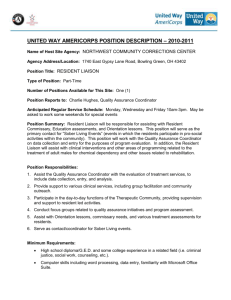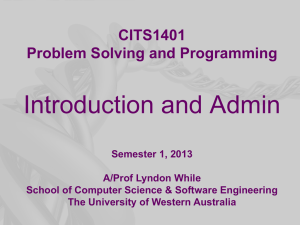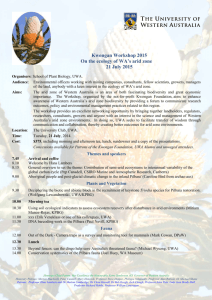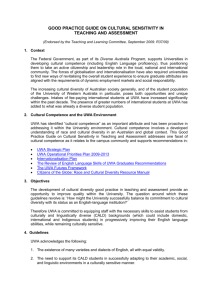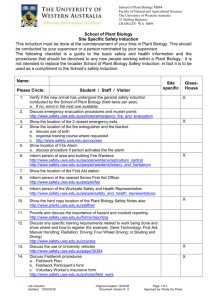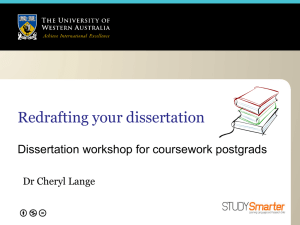Information Services Annual Report 2011 - University Library
advertisement
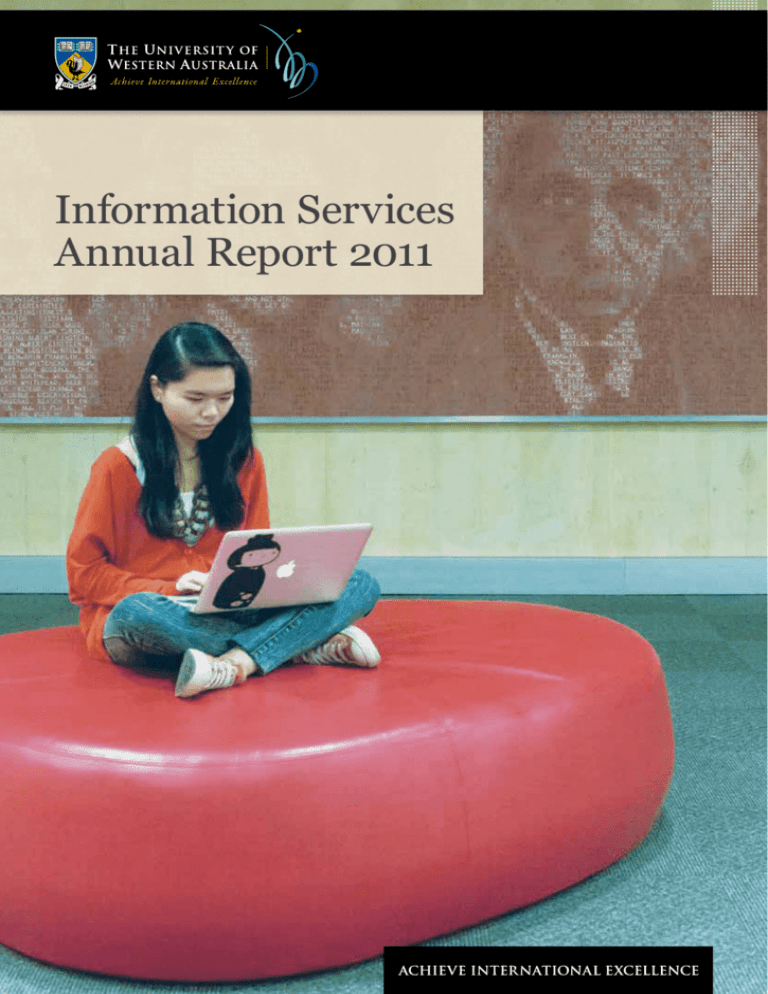
Information Services Annual Report 2011 2011 The new integrated Information Services structure is progressing and the new web site was launched in October 2011. Strategic planning workshops have taken place with the production of a new strategic plan; technical and behavioural competencies have been developed and are being embedded into IS recruitment processes; an organisational development schedule of training has been developed; and a draft skills matrix is being developed for career progression discussions with staff in collaboration with Griffith and Bond universities. There is continuing investment in up-skilling and multi-skilling. There has been a significant shift in the usage of scholarly information with a preference for electronic resources over print. UWA staff and students have been given increased access to information resources with more than 25 major digital collections/archives/ eBooks and journals being made available online. An eBook strategy has been developed and some low use collections have been relocated to off-site storage to help meet the demand for more collaborative learning spaces for students. The new Reid collaborative learning area was opened in November 2011 and has proved extremely popular with students. ii | uwa.edu.au Many of UWA’s research and teaching initiatives are dependent on the outcomes of the Business Investment Programme and work is on-going in liaison with IT staff from Faculties and Central Administration. During the year, the core and distribution layers of the new University network were procured and installed; a new authoritative institutional Active Directory was created; and a new Institutional Data Centre was opened. To support the increasing trend toward ‘anytime, anywhere’ learning and the increasing number of mobile devices on campus, an additional 100 wireless access points were installed as part of Phase 1 of the improved and extended wireless network. A number of organisational changes have been made to better support research. These include the establishment of the eResearch Support and Digital Developments Unit in May 2011, the introduction of Faculty Liaison Coordinators who specifically support researchers within Faculties, and increased IS representation on key Faculty committees. In addition, the Research Impact Measurement Service, targeting early career researchers from the faculties, was piloted and work commenced on a UWA Research Data Management Plan and centralised research data storage. IS’ support for education, especially New Courses 2012, has included: working closely with the Centre for the Advancement of Teaching and Learning (CATL) in the implementation of a new Lecture Capture System (Echo360) and a new Learning Management System (Moodle); collaborating with Student Services to implement the Course Information Database; and video linking a number of lecture theatres to accommodate larger classes. Increasing collaboration with Go8 partners continues. Dr Mary Davies University Librarian and Director (Information Management) Highlights Education ÌÌ To support the increasing trend toward ‘anytime, anywhere’ learning and the increasing number of mobile devices on campus, an additional 100 wireless access points were installed as part of Phase 1 of the improved and extended wireless network. ÌÌ In order to reflect the new integrated Information Services structure, the new Information Services web site, bringing together the Library and ITS web sites, was launched in October 2011. ÌÌ As part of the Business Investment Programme 2011-2013, core and distribution layers of the new University network were procured and installed; a new authoritative institutional active directory was created; and a new institutional data centre was opened. ÌÌ To meet student demand for flexible learning spaces, part of the Reid Library was remodelled to create a large new collaborative learning area. Student and staff friendly spaces were also included in the development of the design for the refurbished EDFAA Library. 02 | uwa.edu.au ÌÌ Working collaboratively with the Centre for the Advancement of Teaching and Learning (CATL), the Lecture Capture System (Echo360) and Learning Management System (Moodle), were delivered within a challenging timeframe. ÌÌ Staff in the Medical and Dental Library assisted senior Faculty staff in the recording of patient case presentations. ÌÌ To meet the deadline for advertising New Courses for 2012, the IS Applications Team worked over a short timeframe in close collaboration with Student Services to implement the Course Information Database. ÌÌ In collaboration with Student Services, Communication and Research Skills (CARS), an online communication skills unit for all commencing students, was designed and developed. ÌÌ To accommodate larger classes as a result of New Courses 2012, video linking was installed in the Alexander and Murdoch Lecture Theatres as well as the Hew Roberts Lecture Theatre and adjacent seminar room. Research and Research Training ÌÌ The new eResearch Support and Digital Developments Unit was established in May 2011 bringing together a range of services and expertise for supporting researchers. ÌÌ Information Services continued to contribute datasets to the Australian Data Archive (formerly the Australian Social Sciences Data Archive). ÌÌ The first batch of UWA records was contributed to Research Data Australia, the national catalogue of research datasets which is managed by the Australian National Data Service (ANDS). ÌÌ In support of the University’s focus on research, RLS (Research and Learning Support Division) piloted a Research Impact Measurement Service, targeting early career researchers from the Faculties. ÌÌ To improve the discoverability of the wide range of information resources provided by Information Services, a single search tool called OneSearch was implemented, enabling clients to search the Library catalogue, databases and the UWA research repository at the same time. ÌÌ UWA staff and students were given increased access to information resources when more than 25 major digital collections/archives/ eBooks and journals were made available online. ÌÌ The Alec King Collection (literature) held in the Scholars’ Centre was catalogued and made available to researchers. ÌÌ In order to meet the growing demand for electronic resources, evidenced from usage statistics, an eBook strategy was developed to focus increasing resources in this area. External Relations ÌÌ Information Services hosted the CAUDIT Enterprise Architecture in Higher Education Symposium 2011. ÌÌ A presentation on the synergies between Information Services staff was made to CAUDIT. ÌÌ A tender process with the WAGUL Joint Purchasing Group for the appointment of a new monographic vendor was completed. ÌÌ To improve collection management of serials, Information Services joined the Go8’s last copy retention scheme. ÌÌ Phase 1 of extending UWA network and technical support to Colleges saw the commencement of the Currie Hall project. People and Resources ÌÌ Recommendations from the ITS Review continued to be implemented. These included an online service catalogue and a University-wide data centre and storage service. ÌÌ Preparatory investigative work and consultation was done for an Information Management Action Plan. ÌÌ System and infrastructure implementations and upgrades included Maximo, Alesco, Cardax, Central DNS, MySource Matrix and Campus Card. ÌÌ To automate the payment of invoices for ordering additional copies of titles already held in the collection, the Millennium Edifact invoicing module was implemented. ÌÌ The transition from Blackwell to YBP for monographic ordering was completed. ÌÌ The use of RFID technology commenced with all EDFAA books being equipped with RFID tags prior to their return to the Nedlands site. This will bring significant benefits in the management of print collections and the ability of clients to utilise collections and lending services independently. ÌÌ To provide additional study space for students, selected print collections were relocated to offsite storage. ÌÌ As part of a strategic plan to provide user-centric services and foster communicative, well-led teams continuously engaged in personal and professional development, a programme of organisational change and up-skilling of IS staff commenced. annual WOW staff award for outstanding contributions by an individual was awarded to Faith Rayney for delivering an efficient and effective service while covering staff leave in her temporary position of Coordinator, Serials Access Management and Budget. ÌÌ Several long-serving members of staff left during the year: Craig Harris, Gaye Harvey, Margaret Jones, Brian Poleykett, Peter Sauvage, Liz Tait and Amina Wilcox. Teresa Chitty, Associate Director of Resources and Development, resigned to take up the position of Associate Librarian, Information Resources and Research Support Services, University of Newcastle. ÌÌ The The University of Western Australia | 03 Education Student Mobility 2012 The anticipated increase in student mobility across Faculties for New Courses 2012 was a key driver for the provision of easy access to PCs and printers all connected to a central University-wide network. Information Services worked closely with Faculties to enable all 2012 students to access data storage and printing services in any general purpose computer lab or library using one single UNIWA login. They would also be able to queue printing to any printer on campus. New printers installed in libraries and computer labs, would use one central print management solution, providing a consistent printing experience and print charging method for students campus wide. 04 | uwa.edu.au Improved IT facilities supported the online CARS (Communication and Research Skills) modules developed as a collaborative project with the StudySmarter Team from UWA’s Student Services. The modules, an expanded version of the former IRIS units, were designed to assist students to develop basic communication and research skills in an academic context. All students can access the modules that cover skills such as working in teams, finding the best evidence, writing assignments and delivering oral presentations. The University of Western Australia | 05 Research and Research Training 06 | uwa.edu.au eResearch Support and Digital Developments The new eResearch Support and Digital Developments Unit, managed by Dr Toby Burrows, brought together a range of services and expertise for supporting researchers. These includes the UWA Research Repository, bibliometrics and research metrics, research data management and data archiving, digitization, digital infrastructure projects, and e-research software. The Unit also manages the Information Services web presence. The Unit carried out an Open Access survey as part of international Open Access Week (24th-30th October). Open Access is free, immediate, online access to the results of publicly funded scholarly research, and the right to use and re-use those results. While many UWA researchers were aware of Open Access, only a minority had actually published in Open Access journals or had deposited material in Open Access repositories. Most researchers said they would be willing to deposit their publications in the UWA Research Repository, given the opportunity. Digital Collections Among the major digital collections added during the year were: ÌÌ American Society of Mechanical Engineers digital archive ÌÌ Begell House engineering research collection ÌÌ Brill Biology ebook collection ÌÌ Brill Martinus Nijhoff eBooks human rights and humanitarian law ÌÌ Cambridge Journals Digital Archive ÌÌ Classiques garnier numerique (Corpus of Francophone literature from the Indian Ocean) ÌÌ The Economist online ÌÌ Education in video ÌÌ Education index retrospective ÌÌ IBISWorld (provides industrybased research for Australia’s 500 industries, its top 2,000 companies and its key business environment indicators) ÌÌ Informaworld archives – Business, management & economics, and Environment & agriculture ÌÌ Inorganic crystal structure database of Latin texts A & B ÌÌ Listener historical archive 1929-1991 ÌÌ London low life : street culture, social reform and the Victorian underworld ÌÌ Nursing reference centre ÌÌ Oxford reports on international law ÌÌ Philanthropy Australia ÌÌ ProQuest art, design and architecture database ÌÌ Romanticism : life literature and landscape ÌÌ Sage Research Methods Online ÌÌ Springer Materials Landolt-Börnstein database ÌÌ Tax and accounting online ÌÌ Urban & Fischer journal archives in300000 biochemistry, immunology and microbiology The number of eBooks has expanded rapidly from a few thousand in 2008 to over 330,000 at the end of 2011. eBooks now represent over a quarter of the total book titles available in the collection (see Figure 1). ÌÌ Library The number of online serials has also been expanding rapidly over this same period and at the end of 2011 UWA staff and students had access to over 113,000 online titles. Conversely, active print serials continued to decline and numbered under 3,500 by the end of 2011 (see Figure 2). This migration from print to online is driven heavily by an increasing preference by UWA staff and 20 students for accessing information resources online rather than in print. 15 Non-reserve Between 2010 and 2011 the volume of loans for print books dropped by Reserve 10 approximately 12% while the use of Total loans per 5eBooks from one of the major eBook student providers (EBL) increased by about 0 15% (see Figure 3). In 2011, there were over 50,000 loans of ebooks from EBL. being 25 250000 200000 Changing Nature of UWA Collections and Usage 150000 Over the past 5 years there have been100000 some significant changes occurring 50000in the make up of the UWA information resources collections. 0 2006 2007 2008 2009 2010 25 300000 250000 20 200000 Figure 1. Books in UWA Collections 15 Non-reserve 10 Reserve 150000 1200000 100000 1000000 50000 800000 0 600000 5 Total loans per student Ebooks 0 2006 2007 2008 2009 Print books 2010 400000 200000 0 2008 2009 2010 2011 Figure 2. Active serials in UWA collections 1200000 1000000 800000 Serial − print 600000 Serials − online 400000 200000 0 2008 2009 2010 2011 The University of Western Australia | 07 25 300000 250000 20 200000 15 Non-reserve 10 Reserve 5 Total loans per student 150000 100000 50000 0 0 2006 2007 2008 2009 2010 25 300000 250000 Similarly, the use of other online material made available via Course Materials Online (the University’s online course readings service) and FindIt (the service that links staff and students to online full text material) far outweighed the use of physical collections and this trend has been increasing over the past 2 years (see Figure 4). 20 200000 Figure 3. Book Loan Statistics 15 Non-reserve 10 Reserve 5 Total loans per Print books (Main collection) student 150000 200,000 100000 150,000 50000 100,000 0 50,000 Print books (Reserve collection) 0 2006 2007 2008 2009 Ebooks (via EBL) 2010 0 2010 2011 Year Figure 4. Loan/Access Statistics University staff and students are increasingly using the University’s online information resources over the print collections and this is driving the focus for Information Services’ to develop online collections, relocate low use materials to off-site storage and create new flexible learning spaces 1,400,000 1,200,000 Print books (Main collection) 1,000,000 Print books (Reserve collection) 800,000 Ebooks (via EBL) 600,000 CMO items − Online 400,000 Online access via Findit 200,000 0 2010 08 | uwa.edu.au Year 2011 External Relations Donations Several academic staff made generous donations to the library collections. In particular, Professor Richard Bosworth and Professor John Melville-Jones each donated a number of books in their respective fields of interest. A large gift of German and English language material was gratefully received from the library of Maurice and Irene Benn. Professor J. M. Lindsay, on the Faculty from 19691986 and a former head of the German Department, left a generous collection of items in his will. A donation of Latin books was received from the estate of Professor R.T.M Whipple. As in previous years Mr. Matthew Preston has donated a number of items to our collections. The Friends of the UWA Library donated four original pen and ink drawings including The Sun-downer by novelist and artist, Hume Nisbet (1849-1923). These drawings of early Australia support our large collection of literature by Nisbet. Friends of the Library Committee 2011 President: E/ Prof David Tunley Vice Presidents: Mr Malcolm Hood Mrs Alison Kennedy Secretary/Treasurer: Ms Stella Ibbott Committee: Dr Robin Adamson Dr Toby Burrows E/Prof Jim Everett Mrs. Gillian Flecker Dr Des Gurry Ms Barbara Hale Dr John Robbins E/Prof Phil Silberstein Ex Officio: Dr Mary Davies The University of Western Australia | 09 People and Resources 10 | uwa.edu.au The Business Investment Programme During 2011, major IT enhancement projects were initiated as part of the Business Investment Programme (BIP), as endorsed for implementation by the Vice Chancellor’s Advisory Group in February 2011. The Programme objective is to raise information technology to be a strategic enabler in support of the University’s vision of becoming a top-50 ranked university in the world by 2050, and to support the changes required for student mobility across faculties, associated with New Courses 2012. Key outcomes to be delivered by the programme include: ÌÌ enhancement of the student experience, ÌÌ facilitation of research and teaching collaborative activities, ÌÌ increased throughput of our research data and its security, ÌÌ increased efficiency and effective working practices, ÌÌ release of staff capacity to better support research and teaching developments, and ÌÌ reduction of risks associated with ineffective data management strategies. BIP is a 3 year programme of work. The focus for 2011 projects included: ÌÌ replacement of the University’s aging data network, ÌÌ consolidation of some 40+ server rooms around campus to address data storage risks, and ÌÌ “Student Mobility”, prioritising those aspects of the programme required to facilitate a much improved and consistent student cross-faculty IT experience to coincide with the introduction of New Courses 2012. Data Network Replacement UWA partnered with global network provider Cisco to develop a new resilient, high speed network, that would provide the throughput capacity anticipated for future “big data” research and emerging online collaborative and teaching technologies. A key design criterion was to enable ease of growth and expansion to address future requirements. Cisco implementation partner Alphawest has worked closely with UWA during 2011 to implement the new design at the core and distribution layers of the network, that is network infrastructure up to the Faculty doors. (In-building networks are referred to as the Access Layer, and will largely be addressed in a subsequent project phase). The Business School, which had an up-to-date Access Layer was fully connected to the new network in October 2011, which validated the network design end-to-end. Data Centre Consolidation UWA has established an Institutional Data Centre through an agreement with data centre provider Amcom. Once the Institutional Data Centre (IDC) service is fully implemented the University will be able to move the data and systems that are currently housed in some 40+ server rooms around campus, all of varying standards, to the IDC. This will ensure that all of our data is secure and backed up in a high standard facility, accessible across dedicated high speed network connections. One of the first services established in the new centre is student data storage facilities, so that at the commencement of the 2012 academic year, all UWA students can store up to 2GB of data in this facility, which they can access from anywhere on the UWA network. Student Mobility 2012 A key driver for BIP project deliverables is to improve student access to IT facilities across campus to better support the student learning experience. With the introduction of New Courses 2012, students will be more mobile across Faculties as they undertake a variety of majors and broadening units. Information Services has worked closely with Faculties to improve the more mobile student IT experience by: a central data storage facility for students in the new Institutional Data Centre such that students can access their data from anywhere (from all computer labs across campus and via the internet). ÌÌ Ability to print to the nearest student printer. Student printers located in libraries and in labs in faculties and schools, now use one central print management solution, providing a consistent printing experience and print charging method for students campus wide. ÌÌ Broader access to General Purpose computer labs – students are able to utilise PCs in general purpose computer labs across campus to access their data storage and printing services using one single login via the new UNIWA active directory. ÌÌ Providing BIP Network and Data Centre Services Launch Event Winthrop Professor Phillip Dolan, Dean of the Business School, hosted a BIP Network and Data Services Launch event in the Business School foyer on December 1 to celebrate the success of the Business School’s transition of IT services to the new BIP provided facilities. The Business School internal network has been connected to the IS managed new network, and all of the Faculty’s servers and data storage migrated to the Institutional Data Centre. Professor Dolan was delighted with the ease at which the transition was achieved, with no impact on the business, and looked forward to the Faculty IT staff now having increased capacity to focus on the future IT requirements for the Business School, rather than tasks associated with servers and network equipment. The University of Western Australia | 11 Vice Chancellor Alan Robson was guest of honour to officially launch the new services, and said “The programme has been highly effective in addressing obstacles that, until now, have been constraining IT within the University. The program has been strategically planned to enable us to have a more resilient network with higher speeds and throughputs, and to provide secure storage capacity to overcome our current data risk which has been raised on numerous occasions by our Auditors. It will continue to match our increasing data-centric research requirements to better support our academics, researchers and students”. Professor Robson thanked Dr Mary Davies and the IS teams for delivering project results in a very short timeframe, and thanked the Business School Faculty Manager, Keith Rappa, and the Faculty IT team for their support of the project, and efforts undertaken to ensure a successful pilot of the new BIP delivered services within their Faculty. Organisational Change and Upskilling One of the most important assets for any organisation is its staff. In Information Services the investment in staff development and upskilling is seen as a priority. Highly skilled and knowledgeable staff will be able to provide a better level of service to our academic community. A major 12 | uwa.edu.au programme was launched in 2011 which brought a number of strands of activity together and involved input from external consultants, Directors of IT and University Librarians from across Australia. The organisational development programme was initiated with all-staff workshops to develop a strategic plan for the service. This resulted in a group of staff authoring the strategy and then presenting this back to all IS staff. A series of briefings were put in place to provide an opportunity for all staff to hear about the bigger picture developments which were having or would have an impact on services. It also provided an opportunity for any staff member to put questions to senior managers directly through round table discussion. This was well received by staff who suggested improvements to the format and content which were then incorporated into future briefings. The first of a series of bigger picture external perspectives was provided by Bruce Meikle CIO University of Sydney giving his perspective from a peer Go8 University. Bruce Callow, from Griffith University provided his experience from an integrated IT and Library service. The activity in 2011 has set the foundation on which to build for 2012 to equip staff with a high level of skill and ultimately provide a better customer experience. RFID Technology Pilot The EDFAA Library flood of March 2010 provided an opportunity to install RFID technology as part of that library’s refurbishment and as a pilot project for the technology at UWA. Towards the end of 2011, over 54,000 monographs housed temporarily in the Reid Library were tagged in preparation for the return of the EDFAA Library to its refurbished site. The use of RFID technology will bring significant benefits in the management of print collections and the ability of borrowers to utilise collections and lending services independently. ÌÌ Manual handling of collections and stocktaking will be easier and more streamlined. ÌÌ A higher rate of self checkout is more easily achieved. ÌÌ Borrowers can renew items, check due dates, check the status of recalled items and other details of their borrower record at the self checkout kiosk. ÌÌ Borrowers can return their own Reserve materials to achieve a quick turnaround of items. Key Statistics and Recurrent Expenditure Key Statistics 2010 2011 Total collection – books (print) 942,875 953,598 Total collection – books (online) 106,399 *175,901 Current serial titles (print) Current serial titles (online) 5,852 3,328 106,593 113,102 Items supplied to other libraries Items borrowed from other libraries 5,460 5,607 12,107 10,473 Information skills sessions Attendance at training sessions 494 454 13,931 11,706 Loans (non-reserve) 173,491 145,754 Loans (reserve) 115,300 105,955 1869 2301 Staff printers and MFDs managed Staff computers managed 476 500 Student computers managed 549 562 Student printers managed Network ports managed Wireless access points Internet total traffic (received) 56 56 13,000 13,550 330 TB 370 228.3 TB 403.1 TB Total storage capacity 330TB 390 TB AV enabled lecture theatres and seminar rooms 224 260 Applications supported e.g. Trim, Alesco, Callista, etc 121 131 *This figure does not include the 156,518 ebl access records Recurrent Expenditure 2010 $A 2011 $A Information resources Books and journal backsets 2,651,311 2,181,039 Current Journals 6,735,016 6,800,373 210,976 170,163 *16,558,185 17,432,518 Document delivery Salaries Operating costs Total recurrent expenditure 4,153,854 4,414,403 30,309,342 30,998,496 *Incorrect figure of $10,238,580 appeared in 2010 Annual Report The University of Western Australia | 13 Senior Staff and Professional Activities Senior Staff as at 31 December 2011 University Librarian and Director (Information Management) Mary Davies BA (Hons) Wales, MSc Salford, DipLib Wales, PhD UCL, MCLIP, MBCS Associate Director, Client Services Alison Trpevski Associate Director, Infrastructure and Operations Stephen Trefry, BSc WAust, Grad Dip Comp WAIT, MBA WAust, MACS Associate Director, Policy and Planning Brian Greene, BComm WAust Associate Director, Research Learning and Support Jill Benn, BA (Hons) ECU, Grad Dip Inf & Lib Stud Curtin AALIA (on parental leave) Associate Director, Resources and Development (Acting) Catherine Clark, BA Murdoch, Grad Dip Inf & Lib Stud Curtin, MIM Curtin, AALIA Enterprise Architect Damian Bramanis, BSc (Hons) WAust Manager, Administration Maxine Gamble Assistant Director, Client Services Delivery Alan Mullett, BBus ECU Assistant Director, Client Services Operations John Creaven, BSc (Hons) GalwayMIT, MSc DublinCU Assistant Director, Research and Learning Support (Arts, Business, Law) (Acting) Carmel O’Sullivan, BA Qld, PG Dip Arts Qld, LLB Qld, Grad Dip LIS QUT 14 | uwa.edu.au Assistant Director, Research and Learning Support (Medicine, Dentistry, Education, ALVA) (Acting) Gina Sjepcevich, BA(Hons) ECU, Grad Dip Inf & Lib Stud Curtin, MCA Curtin Assistant Director, Research and Learning Support (Science and Engineering) (Acting) Merrilee Albatis, BAppSc WAIT, Grad Dip Ed WACAE, Grad Dip Inf & Lib Stud Curtin Manager, eResearch Support & Digital Development Unit Toby Burrows, BA(Hons) WAust, MA Lond, PhD WAust, Grad Dip Lib WAIT Manager, Information Resources Access Management Scott Nicholls, BA Curtin, Grad Dip Inf & Lib Stud Curtin Manager, Network & Communications Mark Curtis, BSEET DITAriz Manager, Servers Daniel Foster, BEnvDes WAust Manager, Special Collections and Projects Erin Fraser, BAppSc WAIT, BA WAIT, MPhil Wales Manager, Teaching Infrastructure Services Terry Coe Professional Activities Davies, M Council of Australian University Librarians: Member Council of Australian University Directors of IT: Member WAGUL: Member WAUDIT: Member Benn, J ALIAWest: Committee Member Curtin Library and Information Studies Alumni: Committee Member Burrows, T Acta Sanctorum: Editorial Board Archives and Manuscripts: Editorial Board AustLit: the Resource for Australian Literature: Advisory Board Bibliographical Society of Australia and New Zealand: Council Education for Information: Editorial Board Literature Online: Advisory Board OCLC systems and services: Editorial Board Parergon: Journal of the Australian and New Zealand Association of Medieval and Early Modern Studies: Editorial Board and Reviews Editor The University of Western Australia, School of Humanities: Honorary Research Fellow Coles, M ALIA Library Technicians Conference Committee Clark, C ALIAWest: Convenor Croker, K ALIA Academic and Research Libraries (WA): Committee Member Renner, F ALIAWest: Committee Member Trefry, S Western Australian Regional Network Organisation (WARNO): Committee Member The University of Western Australia | 15 Conference Papers and Publications 2011 Blake, S. ‘Becoming a trusted advisor: building relationships with research staff through personalised services’. Presented at The ALIA 5th New Librarians Symposium, Perth, Western Australia, 16-18 September 2011. ` Bramanis, D. ‘Enterprise Architecture in Transformational Projects’. Presented at CAUDIT Enterprise Architecture in Higher Education Symposium 2011, Perth, Western Australia, 21-23 November 2011. Burrows, T. ‘Applying Semantic Web technologies to medieval manuscript research’, in: Kodikologie und Paläographie im Digitalen Zeitalter 2 – Codicology and Palaeography in the Digital Age 2, ed. Franz Fischer, Christiane Fritze, Georg Vogeler (Schriften des Instituts für Dokumentologie und Editorik 3) (Norderstedt: Books on Demand, 2010), pp. 117-131. Burrows, T. and den Hartog, L. ‘Building a criminal justice data archive for Australia’. Presented at IASSIST 2011, Vancouver, Canada, 30 May – 3 June 2011. Burrows, T. ‘Building international digital infrastructure: is e-research merely a slogan or a realistic goal?’ Presented at ANZAMEMS 8th Biennial Conference, Dunedin, New Zealand, 2-5 February 2011. Burrows, T. ‘Connecting teachers: the AustLit Database’. Presented at Connections through Literature: All Saints’ College Teachers’ Festival, Perth, Western Australia, 3 September 2011. 16 | uwa.edu.au Burrows, T. ‘Ontology learning and the humanities’, in: Ontology Learning and Knowledge Discovery Using the Web: Challenges and Recent Advances, ed. Wilson Wong, Wei Liu and Mohammed Bennamoun (Hershey, PA: IGI-Global, 2011), pp. 186-199. Burrows, T. ‘Organizing digital resources for cultural heritage research’, in: Safeguard of Cultural Heritage: a Challenge from the Past for the Europe of Tomorrow: COST Strategic Workshop July 11th-13th, Florence, Italy, ed. Marco Foravanti and Saverio Mecca (Firenze: Firenze University Press, 2011), pp. 95-96. Burrows, T. ‘Sharing humanities data for e-research: conceptual and technical issues’, in: Sustainable Data from Digital Research, ed. Nick Thieberger et al. (Melbourne: PARADISEC, 2011), pp. 177-192. Carr , S. Iredell, H. Newton-Smith, C. Clark, C. Evaluation of Information Literacy Skill Development in First Year Medical Students. Australian Academic and ResearchLibraries, 42: 2, pp136-148 2011. Davies, M. ‘Transformational projects to remain globally competitive’. Presented at the CAUDIT Enterprise Architecture in Higher Education Symposium 2011, Perth, Western Australia, 21-23 November 2011. Hallam , G. Ritchie, A. Hamill, C. Lewis, S. O’Connor, P. Kammermann, M. Clark, C. & Newton-Smith, C. Health librarianship workforce and education: research to plan the future. Final Report. Canberra , ALIA, 2011. Humphries, P. and Booker, J. ‘Mind the Gap – or how I learned not to love Google’. Presented at ACTioning the Law, Australian Law Librarians’ Association 2011 Conference, Canberra, ACT, 28-30 September 2011 Lewis, S. Hallam, G. Ritchie, A. Clark, C. Hamill, C. Foti, M. O’Connor, P. Employers’ perspectives on future roles and skills requirements for Australian health librarians. Evidence Based Library and Information Practice 6:4 pp57-71 2011. O’Sullivan, C. and Benn, J. ‘What’s in the box? How the Science Library is challenging tradition at UWA’. Presented at ALIA Online, Sydney, NSW, 2 February 2011. Mills, K. ‘Closing the loop: The use of student feedback in library information literacy instruction’. Presented at ALIA 5th New Librarians Symposium, Perth, WA., 16-18 September 2011. Saw, G. and Davies M. ‘Exploiting synergies between Library & IT’. Presented at the CAUDIT Spring Meeting 2011, Melbourne, 6 October 2011 Sjepcevich, G., Ackroyd, L., & Balfour, H. ‘Catalyst or catastrophe? The aftermath of the Education, Fine Arts and Architecture Library flood’. Presented at ALIA National Library & Information Technicians Conference, Perth, Western Australia, 12-16 September 2011. The University of Western Australia | 17 Information Services The University of Western Australia M209, 35 Stirling Highway Crawley WA 6009 Tel: +61 8 6488 1777 Fax: +61 8 6488 1012 is.uwa.edu.au CRICOS Provider Code: 00126G UniPrint 90718

